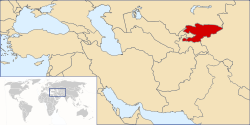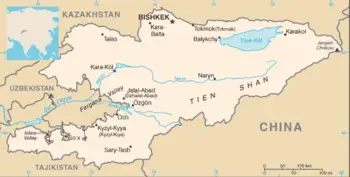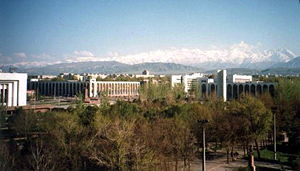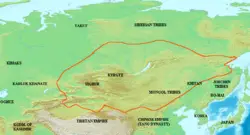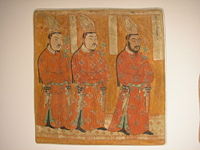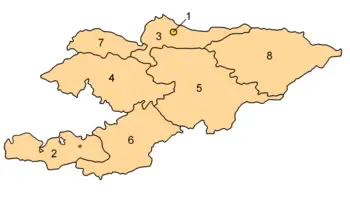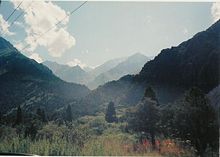Difference between revisions of "Kyrgyzstan" - New World Encyclopedia
Mike Butler (talk | contribs) |
Mike Butler (talk | contribs) |
||
| Line 172: | Line 172: | ||
The Kyrgyz Republic's terrain is mountainous, which accommodates livestock raising, the largest agricultural activity, so the resulting wool, meat, and dairy products are major commodities. Main crops include wheat, sugar beets, potatoes, cotton, tobacco, vegetables, and fruit. As the prices of imported agrichemicals and petroleum are so high, much farming is being done by hand and by horse, as it was generations ago. Agricultural processing is a key component of the industrial economy, as well as one of the most attractive sectors for foreign investment. | The Kyrgyz Republic's terrain is mountainous, which accommodates livestock raising, the largest agricultural activity, so the resulting wool, meat, and dairy products are major commodities. Main crops include wheat, sugar beets, potatoes, cotton, tobacco, vegetables, and fruit. As the prices of imported agrichemicals and petroleum are so high, much farming is being done by hand and by horse, as it was generations ago. Agricultural processing is a key component of the industrial economy, as well as one of the most attractive sectors for foreign investment. | ||
| − | Uncertain land tenure and overall financial insecurity have caused many private farmers to concentrate their capital in | + | Farmland cannot be owned by individuals, but land rights may be held for up to 99 years. Uncertain land tenure and overall financial insecurity have caused many private farmers to concentrate their capital in —livestock—thus subjecting new land to the overgrazing problem. |
The Kyrgyz Republic is rich in mineral resources but has negligible petroleum and natural gas reserves; it imports petroleum and gas. Among its mineral reserves are substantial deposits of coal, gold, uranium, antimony, and other rare-earth metals. Metallurgy is an important industry, and the government hopes to attract foreign investment in this field. The government has actively encouraged foreign involvement in extracting and processing gold. The Kyrgyz Republic's plentiful water resources and mountainous terrain enable it to produce and export large quantities of hydroelectric energy. | The Kyrgyz Republic is rich in mineral resources but has negligible petroleum and natural gas reserves; it imports petroleum and gas. Among its mineral reserves are substantial deposits of coal, gold, uranium, antimony, and other rare-earth metals. Metallurgy is an important industry, and the government hopes to attract foreign investment in this field. The government has actively encouraged foreign involvement in extracting and processing gold. The Kyrgyz Republic's plentiful water resources and mountainous terrain enable it to produce and export large quantities of hydroelectric energy. | ||
Revision as of 20:29, 9 April 2007
| Кыргыз Республикасы Kyrgyz Respublikasy Кыргызская Республика | |||||
| |||||
| Motto: none | |||||
| Anthem: National Anthem of the Kyrgyz Republic | |||||
| Capital (and largest city) |
Bishkek 42°52′N 74°36′E | ||||
| Official languages | Kyrgyz, Russian | ||||
|---|---|---|---|---|---|
| Government | Republic | ||||
| - President | Kurmanbek Bakiyev | ||||
| - Prime Minister | Azim Isabekov | ||||
| Independence | from the Soviet Union | ||||
| - Declared | 31 August 1991 | ||||
| - Completed | 25 December 1991 | ||||
| Area | |||||
| - Total | 199,900 km² (86th) 77,181 sq mi | ||||
| - Water (%) | 3.6 | ||||
| Population | |||||
| - July 2005 estimate | 5,264,000 | ||||
| - 1999 census | 4,896,100 | ||||
| - Density | 26/km² 67/sq mi | ||||
| GDP (PPP) | 2005 estimate | ||||
| - Total | $10.764 billion | ||||
| - Per capita | $2,088 | ||||
| HDI (2004) | |||||
| Currency | Som (KGS)
| ||||
| Time zone | KGT (UTC+6) | ||||
| Internet TLD | .kg | ||||
| Calling code | +996 | ||||
Kyrgyzstan (also “Kyrgyz,” “Kirgizia,” or “Kirghizia”), officially the Kyrgyz Republic, is a country in Central Asia.
Landlocked and mountainous, it borders Kazakhstan to the north, Uzbekistan to the west, Tajikistan to the southwest and the People's Republic of China to the southeast.
Kyrgyzstan means the "Land of Forty Tribes". According to July 2005 estimates, the population was 5,264,000, the large majority (76.1 percent) being Muslims.
Geography
The smallest of the newly independent Central Asian states, Kyrgyzstan is about the same size as the state of Nebraska, with a total area of about of 77,181 square miles (199,900 square kilometres). The national territory extends about 900 kilometers from east to west and 410 kilometers from north to south.
The mountainous region of the Tian Shan covers over 80 percent of the country (Kyrgyzstan is occasionally referred to as "the Switzerland of Central Asia", as a result with the remainder made up of valleys and basins.
The highest peaks are in the Kakshaal-Too range, forming the Chinese border. Peak Jengish Chokusu, at 24,400 feet (7439 meters), is the highest point and is considered by geologists (though not mountaineers) to be the northernmost 23,000-foot (7000meter) peak in the world. Heavy snowfall in winter leads to spring floods that often cause serious damage downstream. The runoff from the mountains is also used for hydro-electricity.
The climate varies regionally. The south-western Fergana Valley is subtropical extremely hot in summer, with temperatures reaching 104°F (40°C). The northern foothills are temperate and the Tian Shan varies from dry continental to polar climate, depending on elevation. In the coldest areas temperatures are sub-zero for around 40 days in winter, and even some desert areas experience constant snowfall in this period.
Lake Issyk-Kul in the north-western Tian Shan is the largest lake in Kyrgyzstan and the second largest mountain lake in the world after Titicaca.
The principal river is the Naryn, flowing west through the Fergana Valley into Uzbekistan, where it meets another of Kyrgyzstan's major rivers, the Kara Darya, forming the Syr Darya which eventually flows into the Aral Sea — although the massive extraction of water for irrigating Uzbekistan's cotton fields now causes the river to dry up long before reaching the Sea. The Chu River also briefly flows through Kyrgyzstan before entering Kazakhstan.
Kyrgyzstan has significant deposits of metals including gold and rare earth metals. Due to the country's predominantly mountainous terrain, less than eight percent of the land is cultivated, and this is concentrated in the northern lowlands and the fringes of the Fergana Valley.
Natural hazards include earthquakes, and major flooding during the snow melt.
Although Kyrgyzstan has abundant water running through it, its water supply is determined by a post-Soviet sharing agreement among the five Central Asian republics. As in the Soviet era, Kyrgyzstan has the right to 25 percent of the water that originates in its territory, but the new agreement allows Turkmenistan and Uzbekistan unlimited use of the water that flows into them from Kyrgyzstan, with no compensation for the nation at the source. Kyrgyzstan uses the entire amount to which the agreement entitles it, but utilization is skewed heavily in favor of agricultural irrigation.
Environmental issues include: Nuclear waste, left behind by the Soviet Union in many open-air pits in hazardous locations; water pollution, since many people get their water directly from contaminated streams and wells; water-borne diseases; increasing soil salinity from faulty irrigation practices; and illegal hunting of rare species, such as the snow leopard and the Marco Polo sheep.
Bishkek in the north is the capital and largest city, with approximately 900,000 inhabitants (as of 2005). The second city is the ancient town of Osh, located in the Fergana Valley near the border with Uzbekistan.
History
Stone implements found in the Tian Shan mountains indicate the presence of human society in what is now Kyrgyzstan as many as 200,000 to 300,000 years ago. The first written records of a civilization in the area occupied by Kyrgyzstan appear in Chinese chronicles beginning about 2000 B.C.E.
According to recent historical findings, Kyrgyz history dates back to 201 B.C.E. The early Kyrgyz lived in the upper Yenisey River valley, central Siberia. The discovery of the Pazyryk and Tashtyk cultures show them as a blend of Turkic and Iranian nomadic tribes. Chinese and Muslim sources of the seventh–twelfth centuries C.E. describe the Kyrgyz as red-haired with fair complexion and green (blue) eyes.
The first Turks to form a state in the territory of Central Asia (including Kyrgyzstan) were Göktürks or Kök-Türks. Known in medieval Chinese sources as Tujue (突厥 tú jué), the Göktürks under the leadership of Bumin/Tuman Khan/Khaghan (d. 552) and his sons established the first known Turkic state around 552 in the general area of territory that had earlier been occupied by the Xiongnu, and expanded rapidly to rule wide territories in Central Asia. The Göktürks split in two rival Khanates, of which the western one disintegrated in 744 C.E.
The first kingdom to emerge from the Qokturk khanate was the Buddhist Uyghur Empire that flourished in the territory encompassing most of Central Asia from 740 to 840 C.E.
After the Uyghur empire disintegrated a branch of the Uyghurs migrated to oasis settlements in the Tarim Basin and Gansu, and set up a confederation of decentralized Buddhist states called Kara-Khoja. Others, closely related to Uyghurs (Qarluks), occupying the western Tarim Basin, Ferghana Valley, Jungaria and parts of modern Kazakhstan bordering the Muslim Turco-Tajik Khwarazm Sultanate, converted to Islam no later than the tenth century and built a federation with Muslim institutions called Kara-Khanlik, whose princely dynasties are called Karakhanids. Its capital, Balasagun flourished as a cultural and economic centre.
The Islamized Qarluk princely clan, the Balasaghunlu Ashinalar (or the Karakhanids) gravitated toward the Persian Islamic cultural zone after their political autonomy and suzerainty over Central Asia was secured during the ninth-tenth century.
The Mongol invasion of Central Asia in the thirteenth century devastated the territory of Kyrgyzstan, costing its people their independence and their written language. The son of (Genghis) Khan, Juche, conquered the Kyrgyz tribes of the Yenisey region. At that time, the area of present Kyrgyzstan was an important link in the Silk Road.
For the next 200 years, the Kyrgyz remained under the Golden Horde and the Oriot and Jumgar khanates that succeeded that regime. Freedom was regained in 1510, but Kyrgyz tribes were overrun in the seventeenth century by the Kalmyks, in the mid-eighteenth century by the Manchus, and in the early nineteenth century by the Uzbeks.
In the early nineteenth century, the southern part of what is today Kyrgyzstan came under the control of the Khanate of Kokand. The territory, then known in Russian as "Kirgizia", was formally incorporated into the Russian Empire in 1876. The Russian takeover instigated numerous revolts against tsarist authority, and many of the Kyrgyz opted to move to the Pamirs and Afghanistan.
In addition, the suppression of the 1916 rebellion in Central Asia caused many Kyrgyz to migrate to China. Since many ethnic groups in the region were (and still are) split between neighbouring states, at a time when borders were more porous and less regulated, it was common to move back and forth over the mountains, depending on where life was perceived as better; this might mean better rains for pasture or better government after oppression.
Soviet power was initially established in the region in 1919 and the Kara-Kyrgyz Autonomous Oblast was created within the Russian SFSR (the term Kara-Kirghiz was used until the mid-1920s by the Russians to distinguish them from the Kazakhs, who were also referred to as Kirghiz). On December 5, 1936, the Kyrgyz Soviet Socialist Republic was established as a full republic of the Soviet Union.
During the 1920s, Kyrgyzstan developed considerably in cultural, educational, and social life. Literacy was greatly improved, and a standard literary language was introduced. Economic and social development also was notable. Many aspects of the Kyrgyz national culture were retained despite the suppression of nationalist activity under Stalin, and, therefore, tensions with the all-Union authorities were constant.
The early years of glasnost had little effect on the political climate in Kyrgyzstan. However, the Republic's press was permitted to adopt a more liberal stance and to establish a new publication, Literaturny Kirghizstan, by the Union of Writers. Unofficial political groups were forbidden, but several groups that emerged in 1989 to deal with the acute housing crisis were permitted to function.
In June 1990, ethnic tensions between Uzbeks and Kyrgyz surfaced in the Osh Oblast, where Uzbeks form a majority of the population. Violent confrontations ensued, and a state of emergency and curfew were introduced. Order was not restored until August 1990.
The early 1990s brought measurable change to Kyrgyzstan. By then, the Kyrgyzstan Democratic Movement (KDM) had developed into a significant political force with support in Parliament. In an upset victory, Askar Akayev, the liberal President of the Kyrgyz Academy of Sciences, was elected to the presidency in October 1990. The following January, Akayev introduced new government structures and appointed a new government comprised mainly of younger, reform-oriented politicians.
In December 1990, the Supreme Soviet voted to change the republic's name to the Republic of Kyrgyzstan. (In 1993, it became the Kyrgyz Republic.) In February 1991, the name of the capital, Frunze, was changed back to its pre-revolutionary name of Bishkek. Despite these aesthetic moves toward independence, economic realities seemed to work against secession from the Soviet Union. In a referendum on the preservation of the Soviet Union in March 1991, 88.7 percent of the voters approved the proposal to retain the Soviet Union as a "renewed federation."
On August 19, 1991, when the State Emergency Committee assumed power in Moscow, there was an attempt to depose Akayev in Kyrgyzstan. After the coup collapsed the following week, Akayev and Vice President German Kuznetsov announced their resignations from the Communist Party of the Soviet Union (CPSU), and the entire bureau and secretariat resigned. This was followed by the Supreme Soviet vote declaring independence from the Soviet Union on August 31, 1991.
In October 1991, Akayev ran unopposed and was elected president of the new independent Republic by direct ballot, receiving 95 percent of the votes cast. Together with the representatives of seven other Republics that same month, he signed the Treaty of the New Economic Community. Finally, on December 21, 1991, Kyrgyzstan joined with the other four Central Asian Republics to formally enter the new Commonwealth of Independent States. In 1992, Kyrgyzstan joined the UN and the Organization for Security and Co-operation in Europe.
The "Tulip Revolution," after the parliamentary elections in March 2005, forced President Akayev's resignation on April 4, 2005. Opposition leaders formed a coalition and a new government was formed under President Kurmanbek Bakiyev and Prime Minister Feliks Kulov.
Political stability appears to be elusive, however, as various groups and factions allegedly linked to organized crime are jockeying for power. Three of the 75 members of parliament elected in March 2005 were assassinated, and another member was assassinated on 10 May, 2006 shortly after winning his murdered brother's seat in a by-election. All four are reputed to have been directly involved in major illegal business ventures.
Politics
The politics of Kyrgyzstan take place in a framework of a semi-presidential representative democratic republic, whereby the president is head of state and the prime minister is head of government, and of multi-party system in development. Executive power is exercised by the government. Legislative power is vested in both the government and parliament.
The constitution was adopted in 1993, amended in 2003 to expand the powers of the president, amended again during demonstrations, in November 2006, granting greater powers to the parliament, and re-amended, in December 2006, returning some power to the president.
The president is elected by popular vote for a five-year term, and is eligible for a second term. An election was last held in July 2005. The prime minister is nominated by the president for approval by parliament.
Under the constitution, the legislature will propose and the president appoint the prime minister, and the prime minister will propose and the president appoint members of the cabinet, except for ministers in charge of defense and security, who are appointed by the president.
A unicameral supreme council or Jorgorku Kenesh comprises 75 members who are elected by popular vote to serve five year terms, although the December 2006 constitution calls for 90 seats. Elections were last held in February-March 2005. Election irregularities caused widespread protests that resulted in the president being forced to flee the country. All aged 18 years of age and over may vote.
The judiciary comprises a supreme court, a constitutional court, a higher court of arbitration and local courts. Judges of both the supreme and constitutional courts are appointed for 10-year terms by the Jorgorku Kenesh on the recommendation of the president. Their age limit is 70 years. Judges for other courts are appointed by the president on the recommendation of the National Council on Legal Affairs for a probationary period of five years, then 10 years. The legal system is based on a civil law system
Corruption problems have plagued the country since its independence from the Soviet Union. Several members of parliament have been murdered.
Current concerns include privatization of state-owned enterprises, expansion of democracy and political freedoms, inter-ethnic relations, and terrorism.
Administrative divisions
Kyrgyzstan is divided into seven provinces or oblast (plural oblasttar) administered by appointed governors. The capital, Bishkek, is administratively an independent city (shaar) with a status equal to a province.
The provinces, and capital city, are as follows: Bishkek, 1; Batken, 2; Chui-Tokmok, 3; Jalal-Abad, 4; Naryn, 5; Osh, 6; Talas, 7; Issyk Kul, 8.
Each province comprises a number of districts (rayon'), administered by government-appointed officials (akim). Rural communities (ayıl ökmötü), consisting of up to 20 small settlements, have their own elected mayors and councils.
Military
The army of Kyrgyzstan includes brigades at Osh and Koi-tash, in the Bishkek area, a special forces brigade, and other units. Air Defense includes a regiment of MiG-21s and Aero L-39s, four Antonov transports, and a helicopter squadron. There are security forces and border troops. Military expenditures totals $19.2 million a year, or 1.4 percent of GDP.
A United States Air Force installation has operated at Manas International Airport near Bishkek since December 2001, as part of Operation Enduring Freedom. US close air support aircraft deployed there included US Air Force F-15Es and US Marine Corp F-18s.
Economy
The Kyrgyz Republic's economy was severely affected by the collapse of the Soviet Union and the resulting loss of its vast market. In 1990, some 98 percent of Kyrgyz exports went to other parts of the Soviet Union. Thus, the nation's economic performance in the early 1990s was worse than any other former Soviet republic except war-torn Armenia, Azerbaijan, and Tajikistan, as factories and state farms collapsed with the disappearance of their traditional markets in the former Soviet Union. While economic performance has improved considerably in the last few years, and particularly since 1998, difficulties remain in securing adequate fiscal revenues and providing an adequate social safety net.
The government has reduced expenditures, ended most price subsidies, and introduced a value-added tax. Overall, the government appears committed to the transition to a market economy. Through economic stabilization and reform, the government seeks to establish a pattern of long-term consistent growth. Reforms led to the Kyrgyz Republic's accession to the World Trade Organization (WTO) in 1998.
Agriculture is an important sector of the economy in the Kyrgyz Republic. By the early 1990s, the private agricultural sector provided between one-third and one-half of some harvests. In 2002 agriculture accounted for 35.6 percent of GDP and about half of employment.
The Kyrgyz Republic's terrain is mountainous, which accommodates livestock raising, the largest agricultural activity, so the resulting wool, meat, and dairy products are major commodities. Main crops include wheat, sugar beets, potatoes, cotton, tobacco, vegetables, and fruit. As the prices of imported agrichemicals and petroleum are so high, much farming is being done by hand and by horse, as it was generations ago. Agricultural processing is a key component of the industrial economy, as well as one of the most attractive sectors for foreign investment.
Farmland cannot be owned by individuals, but land rights may be held for up to 99 years. Uncertain land tenure and overall financial insecurity have caused many private farmers to concentrate their capital in —livestock—thus subjecting new land to the overgrazing problem.
The Kyrgyz Republic is rich in mineral resources but has negligible petroleum and natural gas reserves; it imports petroleum and gas. Among its mineral reserves are substantial deposits of coal, gold, uranium, antimony, and other rare-earth metals. Metallurgy is an important industry, and the government hopes to attract foreign investment in this field. The government has actively encouraged foreign involvement in extracting and processing gold. The Kyrgyz Republic's plentiful water resources and mountainous terrain enable it to produce and export large quantities of hydroelectric energy.
A large amount of local commerce occurs at bazaars and small village kiosks. Commodities such as gas (petrol) are often sold road-side in gallon jugs. A significant amount of trade is unregulated. There is also a scarcity of common everyday consumer items in remote villages. Thus a large number of homes are quite self-sufficient with respect to food production. There is a distinct differentiation between urban and rural economies.
Progress in fighting corruption, further restructuring of domestic industry, and success in attracting foreign investment are keys to future growth.
Exports totalled $701.8-million in 2006. Export commodities included cotton, wool, meat, tobacco, gold, mercury, uranium, natural gas, hydropower, machinery, and shoes. Export partners were United Arab Emirates 35.6 percent, Russia 18.6 percent, China 13.4 percent, and Kazakhstan 13 percent.
Imports totalled $1.177-billion in 2006. Import commodities included oil and gas, machinery and equipment, chemicals, and foodstuffs. Import partners were China 43 percent, Russia 19.7 percent, Kazakhstan 12.1 percent, Turkey 4.4 percent.
Per capita GDP was $2088 in 2005, a rank of 140 on a list of 194 nations.
Demographics
The World Almanac 2005 reported that Kyrgyzstan's population is slightly more than 5 million, estimating it at 5,081,429. Of those, 34.4% are under the age of 15 and 6.2% are over the age of 65. The country is rural; only about one-third (33.9%) of Kyrgyzstan's population live in urban areas. The average population density is 69 people per square mile (29 people per km²).
The nation's largest ethnic group is the Kyrgyz, a Turkic people. The Kyrgyz comprise 69.5% of the population and have historically been semi-nomadic herders, living in round tents called yurts and tending sheep, horses and yaks. This nomadic tradition continues to function seasonally (see transhumance) as herding families return to the high mountain pasture (or jailoo) in the summer. The retention of this nomadic heritage and the freedoms that it assumes continue to have an impact on the political atmosphere in the country. The name Kyrgyz, both for the people and for the nation itself, is said to mean "forty girls", a reference to the Manas of folklore unifying forty tribes against the Mongols.
Other ethnic groups include ethnic Russians (9.0%) concentrated in the North and Uzbeks (14.5%) living in the South. Small but noticeable minorities include Tatars (1.9), Uyghurs (1.1%), Kazakhs (0.7%) and Ukrainians (0.5%). Of the formerly sizable Volga German community, exiled here by Stalin from their earlier homes in the Volga German Republic, most have returned to Germany, and only a few small groups remain. A small percentage of the population are also Soviet Koreans, meaning descendents of the former Korean residents of Vladivostok, who Stalin had exiled to Central Asia (and the Caucauses) during the Second World War.
Languages
Kyrgyzstan is one of two of the five former Soviet republics in Central Asia to retain Russian as an official language (Kazakhistan is the other). It added the Kyrgyz language to become an officially bilingual country in September 1991. This sent a clear signal to the ethnic Russians that they were welcome in the new independent state, in an effort to avoid a brain drain. Kyrgyz is a member of the Turkic group of languages and was written in the Arabic alphabet until the 20th century. Latin script was introduced and adopted in 1928, and was subsequently replaced by Cyrillic in 1941.
Generally, people all over the country understand and speak Russian, except for some remote mountain areas. Russian is mother tongue to the majority of Bishkek dwellers, and most business and political affairs are carried out in this language. Until recently, Kyrgyz remained a language spoken at home, rarely during meetings or other events. However, most parliamentary meetings today are conducted in Kyrgyz, with simultaneous interpretation available for those not speaking Kyrgyz.
Culture
- Manas, an epic poem
- Komuz, a three-stringed lute
- Tush kyiz, large, elaborately embroidered wall hangings
- Shirdak, flat cushions made in shadow-pairs [1]
- other textiles, especially made from felt
- Falconry
Traditions
Illegal, but still practiced, is the tradition of bride kidnapping. [2]
Religion
- Kyrgyzstan is a secular state. During Soviet times, atheism was encouraged.
- About 75% of the population are Muslim, mostly Sunni Muslims of the Hanafi school. Islam in Kyrgyzstan is more of a cultural background than a devout daily practice for most.
- The main Christian churches are Russian Orthodox and Ukrainian Orthodox. A small minority of Germans are Protestant Christians, mostly Lutherans or Baptists.[1]
- Animistic traditions survive, as do influences from Buddhism such as the tying of prayer flags onto sacred trees.
- A small number of Bukharian Jews had also lived in Kyrgyzstan, but during the collapse of the Soviet Union most fled to other countries, mainly the United States and Israel.
Flag
The 40-rayed yellow sun in the center of the flag represents 40 warriors of the mythical hero Manas. The lines inside the sun represents the crown or tunduk (Kyrgyz түндүк) of a yurt, a symbol replicated in many facets of Kyrgyz architecture. The red portion of the flag represents peace and openness of Kyrgyzstan.
Education
Eductional institutions in Kyrgyzstan include but are not limited to:
- The American University of Central Asia.
- KRSU - Kyrgyz Russian Slavonic University .
- KNU - Kyrgyz National University.
- Kyrgyz-Turkish MANAS University
- Bishkek Humanities University
- International University of Kyrgyzstan
- International Ataturk-Alatoo University
Horse riding
The traditional national sports reflect the importance of horse riding in Kyrgyz culture. Very popular, as in all of Central Asia, is Kok Boru (meaning "blue wolf"), a team game something between polo and rugby on horseback, in which the two teams attempt to deliver the headless carcass of a goat across the opposition's goal line or, in today's somewhat more regulated version, into the opposition's goal, a big tub or a circle marked on the ground. During a match the players seek to wrestle the goat from their opponents.
Other popular games on horseback are Tyiyn or Tenghe Enish (picking up a coin from the ground at full gallop), Kyz Kuumai (chasing a girl in order to win a kiss from her, while she gallops away and may lash the pursuer with her horse whip), Oodarysh (wrestling on horseback), long-distance horse races over 15, 20 or even 50 and 100 kilometers, and others.
Miscellaneous topics
- Communications in Kyrgyzstan
- Foreign relations of Kyrgyzstan
- Kyrgyzstan at the 2004 Summer Olympics
- Kyrgyz parliamentary elections, 2005
- Kyrgyz presidential election, 2005
- List of birds of Kyrgyzstan
- List of cities in Kyrgyzstan
- Military of Kyrgyzstan
- Scouting in Kyrgyzstan
- Transport in Kyrgyzstan
- Tulip Revolution
- Postage stamps and postal history of Kyrgyzstan
- Manas Air Base
Further reading
- Historical Dictionary of Kyrgyzstan by Rafis Abazov
- Kyrgyzstan: Central Asia's Island of Democracy? by John Anderson
- Kyrgyzstan: The Growth and Influence of Islam in the Nations of Asia and Central Asia by Daniel E. Harmon
- Lonely Planet Guide: Central Asia by Paul Clammer, Michael Kohn and Bradley Mayhew
- Odyssey Guide: Kyrgyz Republic by Ceri Fairclough, Rowan Stewart and Susie Weldon
- "Silk Road to Ruin: Is Central Asia the New Middle East?" by Ted Rall
- "Kyrgyzstan: Traditions of Nomads," by V. Kadyrov, Rarity Ltd., Bishkek, 2005 ISBN 9967-424-42-7
Notes
External links
- Government of Kyrgyzstan official site
- President of the Kyrgyz Republic
- Kyrgyzstan Ministry of External Trade and Industry
- Kyrgyz State Television and Radio
- Eurasianet - Kyrgyzstan Daily Digest news
- Common Language Project Country Fact Sheet - Kyrgyzstan
- Open Directory Project - Kyrgyzstan directory category
- PBS documentary on Kyrgyz bride "kidnapping" March 2004
- Photos of traditional life in Kyrgyzstan
- Photo gallery and information about Kyrgyzstan - in German
- Traditional felt making in Kyrgyzstan, journal by Dutch designer Sietze Kalkwijk
- Kyrgyzstan's location on a 3D globe (Java)
- KyrgyzReport.com ongoing analysis, including an analysis of the clusters of political forces in Kyrgyzstan and the roots of the country’s political problems
- Kyrgyzstan Destinations Guide if you're interested in learning something about the country and the opportunities it has to offer present day travelers.
Template:Countries of Central Asia
Afghanistan · Armenia · Azerbaijan1 · Bahrain · Bangladesh · Bhutan · Brunei · Cambodia · China, People's Republic of · China, Republic of (Taiwan)2 · Cyprus · Egypt3 · Georgia1 · India · Indonesia4 · Iran · Iraq · Israel · Japan · Jordan · Kazakhstan1 · Korea, Democratic People's Republic of · Korea, Republic of · Kuwait · Kyrgyzstan · Laos · Lebanon · Malaysia · Maldives · Mongolia · Myanmar · Nepal · Oman · Pakistan · Philippines · Qatar · Russia1 · Saudi Arabia · Singapore · Sri Lanka · Syria · Tajikistan · Thailand · Timor-Leste (East Timor)4 · Turkey1 · Turkmenistan · United Arab Emirates · Uzbekistan · Vietnam · Yemen3
For dependent and other territories, see Dependent territory and List of unrecognized countries.
1 Partly or significantly in Europe.
2 The Republic of China (Taiwan) is not officially recognized by the United Nations; see Political status of Taiwan.
3 Partly or significantly in Africa.
4 Partly or wholly reckoned in Oceania.
Template:Commonwealth of Independent States Template:Eurasian Economic Community
| Member states and observers of the Organization of the Islamic Conference (OIC) | |||||||
|---|---|---|---|---|---|---|---|
| Members |
| ||||||
| Observers |
| ||||||
Federal subjects of Russia shown in italics
Western Turkic |
|
|
|
1 Includes the Nakhchivan Autonomous Republic. 2 Recognized only by Turkey; see Cyprus dispute.
Credits
New World Encyclopedia writers and editors rewrote and completed the Wikipedia article in accordance with New World Encyclopedia standards. This article abides by terms of the Creative Commons CC-by-sa 3.0 License (CC-by-sa), which may be used and disseminated with proper attribution. Credit is due under the terms of this license that can reference both the New World Encyclopedia contributors and the selfless volunteer contributors of the Wikimedia Foundation. To cite this article click here for a list of acceptable citing formats.The history of earlier contributions by wikipedians is accessible to researchers here:
The history of this article since it was imported to New World Encyclopedia:
Note: Some restrictions may apply to use of individual images which are separately licensed.


